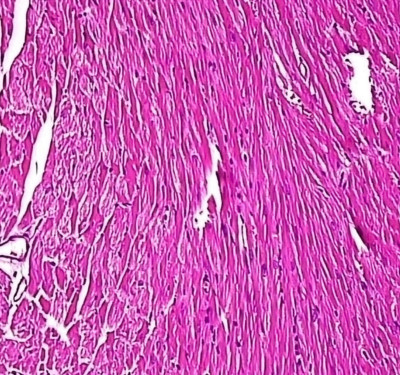A sodium channel therapeutic target
The discovery that a certain gene plays an important role in the rate of conduction in heart cells suggests new treatment options for some heart diseases
Published online 28 February 2015

Photomicrograph of heart muscle fibers.
© Phanie / Alamy
Recent large-scale genomic studies have identified a sodium channel isoform that seems to be responsible for the heart’s ability to conduct electrical impulses. A new review by Thomas Zimmer of Friedrich Schiller University in Germany summarises the new findings, and how they may eventually lead to novel treatments for a variety of life-threatening heart conditions1.
Voltage-gated sodium channels are barrel-shaped proteins embedded in the membranes of electrically excitable cells, such as neurons and heart muscle. They control the cells’ electrical properties by regulating the inward flow of sodium ions through a central pore.
Mammals express nine different sodium channel isoforms, which are made up of multiple subunits, and are largely characterized by their sensitivity to tetrodotoxin (TTX), which can block their function by plugging the pore. Three of these channels — Nav1.5, which is expressed in the heart, and Nav1.8 and Nav1.9, which are expressed by nerve cells — are relatively resistant to TTX, whereas the other six, expressed in skeletal muscle and the central and peripheral nervous systems, are highly sensitive to it.
A number of recent genome-wide association studies have shown that the SCN10A gene, which encodes sodium channel Nav1.8, determines the conduction properties of heart cells, even though it is found in relatively low levels in the organ. Mutations in this gene are also associated with Brugada syndrome, a condition that causes heart beats irregularities.
“The discovery of Nav1.8 as a relevant player in the heart is another important milestone towards the understanding of cardiac excitability,” says Zimmer. “The actual role [it plays] in the heart remains obscure [but] ongoing research may solve this issue.”
Other studies show that Nav1.8 is expressed in neurons in the heart, suggesting that it regulates the electrical activity of these cells. It is also found in heart muscle cells, and SCN10A is now known to also regulate expression of Nav1.5, the most prominent sodium channel in the heart, by interacting with the SCN5A gene.
These recent findings suggest that SCN10A/Nav1.8 may be a target that could potentially lead to novel treatments for Brugada syndrome and other related conditions. The next step is to understand how exactly SCN10A exerts its effect, explains Zimmer.
“It is important to clarify whether the essential function of SCN10A occurs via regulating SCN5A expression or via the electrophysiological properties of the gene product Nav1.8, and to demonstrate in which cardiac cells of the human heart the channel is expressed,”he adds.Reference
- Zimmer, T., Haufe, V. & Blechschmidt, S. R. Voltage-gated sodium channels in the mammalian heart. Glob. Cardiol. Sci. Pract. 2014, 58 (2014). | article
DOI: 10.1038/qsh.2015.52

